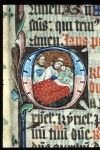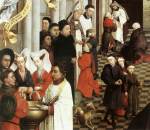Derived from the Greek word chrisma, meaning “anoint,” the same root word for Christós (or “anointed one”), the chrismatory was a receptacle for the oil used in sacramental rites of passage and church ceremonie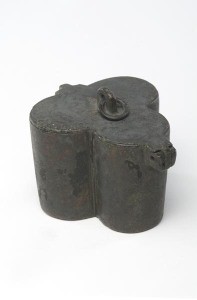 s. Measuring 47 millimeters (or 1.85 inches) in height and 78 millimeters (or 3.07 inches) in width, this late medieval, three-chambered chrismatory was made of lead alloy. Shaped as a trefoil, or three-leaved plant, it is relatively unadorned and unembellished compared to other chrismatories found in medieval London. About half of all London churches had chrismatories of silver, and many of them sported intricate designs, such as engravings of evangelists or even royal coats of arms. The Bishop, usually on Holy Thursday, blessed the chrismatory oil, which was placed in its three separate compartments (representing the “leaves” of the trefoil) and according to type. First, there was the oil of catechumens, which was used for the sacrament of baptism. Second, the oil for anointing the sick, derived from olive oil or oil from another plant. Lastly, there was the holy chrism, which was a mixture of olive oil and balsam, and used for confirmation and ordination ceremonies.
s. Measuring 47 millimeters (or 1.85 inches) in height and 78 millimeters (or 3.07 inches) in width, this late medieval, three-chambered chrismatory was made of lead alloy. Shaped as a trefoil, or three-leaved plant, it is relatively unadorned and unembellished compared to other chrismatories found in medieval London. About half of all London churches had chrismatories of silver, and many of them sported intricate designs, such as engravings of evangelists or even royal coats of arms. The Bishop, usually on Holy Thursday, blessed the chrismatory oil, which was placed in its three separate compartments (representing the “leaves” of the trefoil) and according to type. First, there was the oil of catechumens, which was used for the sacrament of baptism. Second, the oil for anointing the sick, derived from olive oil or oil from another plant. Lastly, there was the holy chrism, which was a mixture of olive oil and balsam, and used for confirmation and ordination ceremonies.
The circular (suspension?) clasp allowed individuals to open the lid easily, and 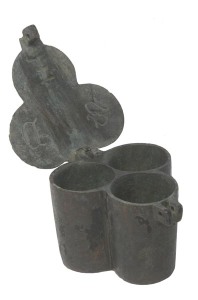 the loops underneath the lid allowed it to stay closed with a lock. The inside of the lid is etched with the letters “C” (for chrisma) on the lower-left side, “I” (for oleum Infirmorum, or “oil of the sick”) on the top, and “B” (oleum Catechumenorum, or “oil of catechumens,” used for baptism) on the lower-right side. These identifying letters helped the priest choose the oil needed for the right occasion. When the chrismatory was not in use it was usually stored away in the sacristy. The chrismatory was both a holy and a practical object, and this one was likely one of many of its kind, as lead alloy was meant to last and cost less than chrismatories made of more expensive metals. This chrismatory may have been made from metals mined in Cornwall or Devon, and manufactured by one of the many metalworkers in London, although the provenance of this object, and where it was excavated in London, is unknown.
the loops underneath the lid allowed it to stay closed with a lock. The inside of the lid is etched with the letters “C” (for chrisma) on the lower-left side, “I” (for oleum Infirmorum, or “oil of the sick”) on the top, and “B” (oleum Catechumenorum, or “oil of catechumens,” used for baptism) on the lower-right side. These identifying letters helped the priest choose the oil needed for the right occasion. When the chrismatory was not in use it was usually stored away in the sacristy. The chrismatory was both a holy and a practical object, and this one was likely one of many of its kind, as lead alloy was meant to last and cost less than chrismatories made of more expensive metals. This chrismatory may have been made from metals mined in Cornwall or Devon, and manufactured by one of the many metalworkers in London, although the provenance of this object, and where it was excavated in London, is unknown.
This chrismatory is available to view at the Museum of London.
– Esther Cuenca
Further Reading
“Chrism” and “Chrismatory.” In The Oxford Dictionary of the Christian Church, eds. Frank Leslie Cross and Elizabeth A. Livingstone, 334-5. Oxford: Oxford University Press, 2005.
Homer, Ronald F. “Tin, Lead, and Pewter.” In English Medieval Industries: Craftsmen, Techniques, Products, eds. John Blair and Nigel Ramsay, 57-80. London: Hambledon Press, 1991.
Oman, Charles. “English Medieval Base Metal Church Plate.” Archaeological Journal 119:1 (1962): 195-207.
Related Items
 Seven Sacraments Altarpiece (detail of confirmation), Rogier Rogier van der Weyden (1399 or 1400 – 18 June 1464). A Bishop is anointing a boy with the chrism, in a confirmation ceremony, while holding a gilded chrismatory, in the left panel of the altarpiece, dated 1445-1450. On display at Koninklijk Museum voor Schone Kunsten, Antwerp.
Seven Sacraments Altarpiece (detail of confirmation), Rogier Rogier van der Weyden (1399 or 1400 – 18 June 1464). A Bishop is anointing a boy with the chrism, in a confirmation ceremony, while holding a gilded chrismatory, in the left panel of the altarpiece, dated 1445-1450. On display at Koninklijk Museum voor Schone Kunsten, Antwerp.
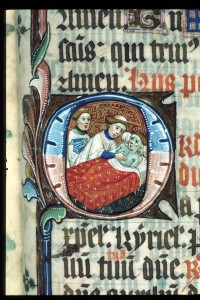
Detail of historiated initial ‘O'(rdo) of a monk providing Extreme Unction to a man in bed. The monk in the background is holding a chrismatory. Detail from British Library MS Landsowne 451, f. 234.
